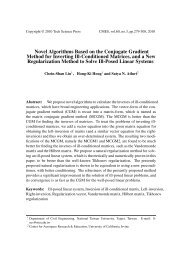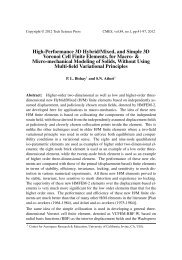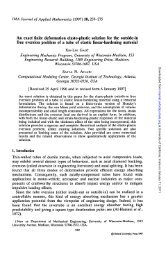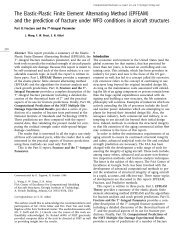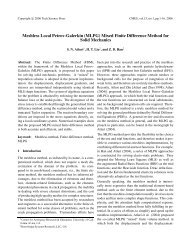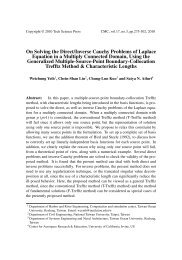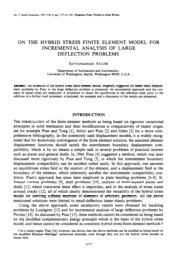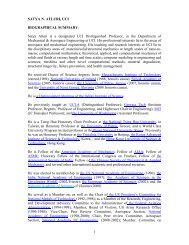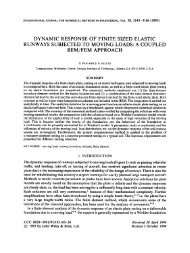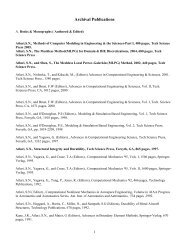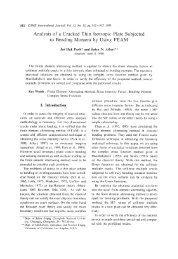A Scalar Homotopy Method for Solving an Over ... - TechScience
A Scalar Homotopy Method for Solving an Over ... - TechScience
A Scalar Homotopy Method for Solving an Over ... - TechScience
Create successful ePaper yourself
Turn your PDF publications into a flip-book with our unique Google optimized e-Paper software.
56 Copyright © 2009 Tech Science Press CMES, vol.53, no.1, pp.47-71, 2009We solved this problem by the Fictitious Time Integration <strong>Method</strong> (FTIM) also, inorder to compare the results with the present approach. However, it is found thatthe third <strong>an</strong>d fourth roots c<strong>an</strong>not be obtained by the FTIM, unless the initial guessis very close to the exact solutions. It appears that some roots of NAEs may not beeasily solved by FTIM if the initial guess c<strong>an</strong>not be chosen appropriately, i.e., theinitial guess is not within the attracting zone of the root.3.2 Example 2We study the following system of two algebraic equations [Spedicato <strong>an</strong>d Hunag(1997)]:F 1 (x,y) = x − y 2 = 0,F 2 (x,y) = (y − 1) 2 (y − 2) 2 + ( x − y 2) 2= 0. (37)The two real roots are (x, y) = (1, 1) <strong>an</strong>d (x, y) = (4, 2). For this example, theconvergence criterion is chosen as ε=10 −7 .For the first root, the initial guess is chosen as (0, 10). After 3424 steps, the solutionof (1.00055782102710, 1.00027890021624) is obtained. The residual of eachequation is (F 1 ,F 2 ) = ( - 0.57190704394472, 0.77741951246269) × 10 −7 .For the second root, the initial guess is chosen as (3, 9). After 30904 steps, thesolution of (3.99989872456104, 1.99997466649739) is obtained. The residual ofeach equation is (F 1 ,F 2 ) = (0.57929709473825, 0.00641757193548) × 10 −7 .The residual norm versus the evolution step number is illustrated in Fig. 1, <strong>an</strong>dthe locus of evolution <strong>for</strong> each root is plotted in Fig. 2. The trajectories as shownin Fig. 2 do not look like continuous curves because the restart method is used.Every time when one restarts, the evolution <strong>for</strong>ces refresh from t= 0 <strong>an</strong>d are totallydifferent from the previous step. We also solved this example by the FTIM, but theresidual norm is still 9.1869×10 −6 after 100000 evolution steps. It c<strong>an</strong> be seen thatthe present scalar homotopy method is much faster th<strong>an</strong> the FTIM <strong>for</strong> this example.In comparison, the scalar homotopy method reaches a more accurate result th<strong>an</strong> theFTIM <strong>for</strong> the same number of evolution steps.3.3 Example 3Now we consider a system of two algebraic equations in two-variables [Hirsch <strong>an</strong>dSmale (1979)]:F 1 (x,y) = x 3 − 3xy 2 + a 1(2x 2 + xy ) + b 1 y 2 + c 1 x + a 2 y = 0,



